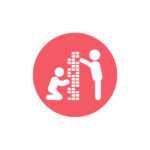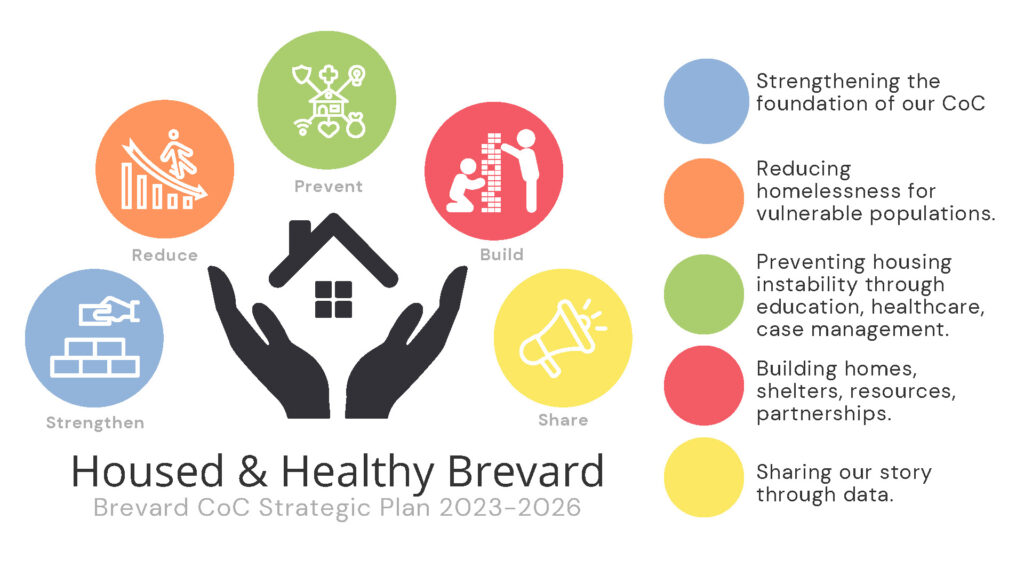All In: HUD’s Federal Strategic Plan to End Homelessness sets an ambitious goal to reduce homelessness 25% by 2025 and encourages state and local governments to use the plan as a blueprint for developing their own strategic plans and for setting their own ambitious goals for 2025. The Brevard CoC strategic plan seeks to closely align with HUD’s plan by:
The Brevard Continuum of Care (CoC) 2023-2026 strategic plan represents a year-long process filled with focused conversations, workshops, research, and trend analysis of Housing and Urban Development (HUD)-required reporting such as the Point-In-Time Count (PITC). The update to our previous 3-year strategic plan began in earnest in May 2022. The Brevard Homeless Coalition (BHC), which serves as the Lead Agency for the Brevard CoC, began to hold focus group sessions within the existing CoC structure, including the General Membership and the Advisory Council members. Focus group sessions were also held with the BHC’s Board of Directors. These conversations were invaluable and helped to guide further discussions with both member and non-member organizations. The BHC asked questions such as:
We then further honed in on seven key areas that warranted additional discussion, and again asked questions of providers working in these areas about gaps and barriers in the delivery of services. The seven key areas were:
Holding a health equity forum, in November 2022, provided invaluable information in the development of the strategic plan through the lens of equitable access of our CoC services.
During this time, Brevard County spearheaded the development of the federal HOME-American Rescue Plan Act (ARP) Allocation Plan, in partnership with other HOME Consortium entities: the City of Cocoa, City of Melbourne, City of Palm Bay, and the City of Titusville. The County engaged the Cloudburst Group as consultants to hold focus groups with County and municipality staff and provider agencies, and to develop the Allocation Plan. We tapped into this robust process as well to gain additional learnings and to ensure consistencies as our respective plans were developed.
From all of these conversations, key themes and areas of need began to emerge:
No small tasks here!
These key themes led us down the path of viewing our strategic plan through our core values and belief statements:
We believe…
Housing is Healthcare.
In taking a Whole Person Approach – mentally, emotionally, physically, spiritually, and relationally.
Providing Care for Case Management, both for the client and the case manager.
In Equity with equitable access to all parts of the Continuum of Care.
With those core values, the Housed & Healthy Brevard Strategic Plan 2023-2026, came into focus.
At the BHC, our mission is to make homelessness a rare, brief, and non-reoccurring event for our community friends and neighbors. Together with the Brevard CoC, five key goals will lay the foundation for our success:

Strengthen. Strengthening the existing foundation for our Continuum of Care through governance, funding, and community engagement. The CoC represents the ground floor from which all other priorities are supported.

Reduce. Reducing the number and length of time people experience homelessness, including those who are chronically homeless and those fleeing domestic violence. To accomplish this, we must expand upon a diversified outreach approach to meet our most vulnerable populations where they are and grow our Coordinated Entry System for streamlined and efficient placement into housing. Utilizing our By Name List will ensure we are always keeping the client in the forefront of the process.

Prevent. Prevention is a first, best strategy. Preventing housing instability by increasing educational, social, health, and financial service supports to our most vulnerable populations, including our veterans. Partnerships with area agencies will help us to achieve this with the goal of embedding programs and practices into our Coordinated Entry process. When we think about prevention, we also think about our system’s case managers and the encompassing role they play in keeping clients stably housed and healthy through diversion and other efforts. As a CoC, we prioritize supporting our case managers through high quality educational opportunities, emotional support, and best practice caseloads to mitigate burn out and system turnover.

Build. Building upon and creating new multi-sector partnerships thereby increasing the number of affordable housing units, and shelter beds through innovative solutions. Our Continuum of Care and the Brevard Homeless Coalition as the Lead Agency place a special focus on those individuals who are elderly, elderly with memory disorders, those who are physically or cognitively disabled as well as individuals within our Coordinated Entry system. Building new units is a longer-term goal as the planning and development process takes time. But we can start developing the relationships now. More immediately, we can grow our number of shelter, rapid re-housing, and permanent supportive housing beds and have set an ambitious goal to do so.

Share. Sharing stories of homelessness and vulnerability within the CoC and to the broader community. Data is a powerful tool in storytelling. Documenting with fidelity in HMIS will allow the CoC and Lead Agency to turn data analytics into a compelling narrative. Sharing the human experience grounds the data on a personal level.
Our plan sets forth ambitious goals and objectives coupled with key measurements of success. These measurements are largely based on HUD’s System Performance Measures, which are utilized to assess CoC’s nationwide, the HUD Longitudinal Systems Analysis (LSA), the 2023 PITC, and the 2023 Housing Inventory Count. The plan also sets forth the structure for CoC committees and workgroups.
Finally, we’d like to thank all of our CoC members, the CoC Advisory Council, the BHC Board of Directors, and the many individuals who shared their vision for a Housed & Healthy Brevard.
Join us in making our vision a reality.

Strengthen the existing foundation for our Continuum of Care (CoC) through governance, funding, and community engagement. The CoC represents the ground floor from which all other priorities are supported.
Click here for our Year 1 Action Plan.
Reduce the number and length of time of people experiencing homelessness, including those who are chronically homeless, and those fleeing domestic violence. This priority area calls for the expansion of diversified outreach to our most vulnerable populations and of the Coordinated Entry system.
Reduce the # of households and people served in the homeless system. **2023 is expected to reflect an increase in this # before a decrease in years 2 & 3 due to expanded diversified outreach and implementation of ERA funding.
1732 Households
2675 Individuals
1300 Households
2000 Individuals
Reduce the average # of days homeless
188 Avg.
141 Days
Increase the percentage of successful permanent housing placements and/or retention.
48%
73%
Click here for our Year 1 Action Plan.
Prevent housing instability by increasing educational, social, health, and financial service supports to our most vulnerable populations including our veterans. Prevention is a first, best strategy. Case management holds the key to providing the support and connections needed to guide people toward stability. In turn, we hold the key to supporting our Case Managers through high quality educational opportunities, emotional support, and case management best practices.
Prevent first time homelessness by reducing the # of individuals accessing the the CoC.
1442
1081
Increase job and income growth for the CoC Program participants.
Employment Income: 24%
Non-earned Income: 7%
Employment: 49%
Non-earned: 34%
Prevent returns to homelessness after permanent Placement within year one and year two.
Within Year 1 – 11%
Within Year 2 – 26%
Year 1 – 8%
Year 2 – 10%
Click here for our Year 1 Action Plan.
Build upon and create new multisector partnerships to increase the number of affordable housing units, and shelter beds through innovative solutions. The CoC and Lead Agency place a special focus on those individuals who are elderly, elderly with memory disorders, those who are physically or cognitively disabled as well as individuals as established by the Coordinated Entry process.
Increase the number of Rapid Rehousing and Permanent Supportive Housing Beds available. Increase 25% each year.
RRH – 920
PH/PSH – 207
PH/OPH – 236
R.R.H. 1800
P.S.H. 400
O.P.H. 461
Increase the number of Shelter Beds available. Increase 25% each year. 2022 HIC Total #: 615
ES – 221
SH – 21
TH – 373
1200
Click here for our Year 1 Action Plan.
Share stories of homelessness and vulnerability within the CoC and to the broader community. Data is a powerful tool in storytelling. Documenting with fidelity in HMIS will allow the CoC and Lead Agency to turn data analytics into a compelling narrative. Sharing the human experience grounds the data on a personal level.
Click here for our Year 1 Action Plan.
Copyright © 2023 Brevard Homeless Coalition – All Rights Reserved